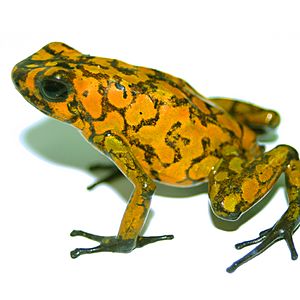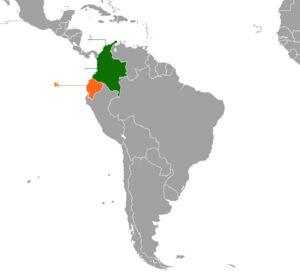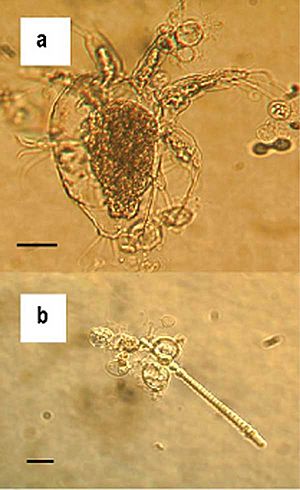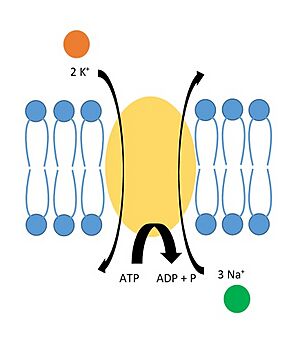Oophaga sylvatica facts for kids
Quick facts for kids Oophaga sylvatica |
|
|---|---|
 |
|
| Conservation status | |
| Scientific classification | |
| Synonyms | |
|
Dendrobates histrionicus sylvaticus Funkhouser, 1956 |
The Oophaga sylvatica, also known by its Spanish name diablito (meaning "little devil"), is a type of frog. It belongs to the Dendrobatidae family, which includes poison dart frogs. You can find this frog in southwestern Colombia and northwestern Ecuador.
These frogs live in rainforests, both in lowlands and on mountainsides. They can even survive in areas where the forest has been slightly changed, especially in humid places. The diablito frog is quite common in Colombia, but its numbers have dropped in many parts of Ecuador. It is currently considered a Near Threatened species. This means it could become endangered if its habitat continues to shrink due to deforestation (forest clearing) and agricultural pollution. Sometimes, these frogs are also illegally sold as pets.
Oophaga sylvatica frogs come in many different colors and patterns. For example, in one protected area in Ecuador, you can find them in red, yellow, and orange colors!
Contents
What Does the Diablito Frog Look Like?
Oophaga sylvatica frogs are usually between 26 and 38 millimeters long. That's about the size of a large paperclip! Males are only a tiny bit bigger than females. Among their close relatives, these frogs are the largest.
These frogs have bright, eye-catching colors. This is called aposematic coloration. It's like a warning sign to animals that might want to eat them. The bright colors tell predators, "I taste bad!" or "I'm poisonous!" The colors can be orange, black, and other similar shades. These colors help them blend in with the forest floor, which is often full of leaves and shadows. Their skin is smooth, and they don't have webbing between their toes.
Where Do Diablito Frogs Live?
The Oophaga sylvatica frog naturally lives in parts of southwestern Colombia and northwestern Ecuador. They prefer humid tropical forests, from lowlands up to about 1,000 meters (about 3,300 feet) above sea level.
You can find these frogs in different parts of the forest, like near rivers, along riverbanks, and deep inside the forest. Areas near rivers usually have the most types of frogs. Riverbanks often have unique and rare species. The deep forest is important because it's where these frogs raise their young.
Protecting Their Home
Oophaga sylvatica can live in some disturbed areas, like farms. However, they mostly live in untouched, or "primary," forests. This is because their young need special plants called bromeliads to grow, and these plants are not found in disturbed areas.
Because they are easy to spot and make noise during the day, Oophaga sylvatica frogs are good indicators of how healthy a forest is. If you see many of them, it's a good sign the forest is doing well!
The IUCN lists Oophaga sylvatica as a Near Threatened species. This means their numbers are going down. Their homes are being destroyed by people clearing forests for farms, logging, mining, and building new towns. Pollution also harms them.
Colombia has started projects to help save these frogs. One project, called EBC, teaches local communities about the diablito frog and how to protect it. They even have a "Festival of the Diablito Frog" to raise awareness!
What Do Diablito Frogs Eat?
Oophaga sylvatica frogs mainly eat small insects found in the leaf litter on the forest floor. Their favorite food is ants, which can make up 40% to 86% of their diet! They eat many different kinds of ants. They also munch on tiny mites and springtails, but not as much.
The ants and mites these frogs eat are very important. They contain special chemicals called alkaloids. The frogs absorb these alkaloids and store them in their skin. These stored alkaloids are what make the frogs poisonous and help protect them from predators.
If a forest is cut down and turned into farmland, the frogs' diet changes. They have fewer types of ants and mites to eat. This means they get fewer types of alkaloids, making them less poisonous and less protected.
Reproduction and Life Cycle
Male Oophaga sylvatica frogs fertilize the eggs outside the female's body. These frogs lay fewer, larger eggs on land, usually in or near small puddles. This is different from many frogs that lay eggs in water. Laying fewer, larger eggs gives each baby frog more resources to grow, helping them survive better on land. A female usually lays between 4 and 20 eggs at a time.
Mating Calls and Rituals
Male frogs make mating calls from their territories, usually from 6 AM to 7 PM. Their calls are short and high-pitched, about 5 calls per second. They often call from high places so they can be heard and seen better. Scientists think that because these frogs are so brightly colored and protected by their toxins, they can afford to have more varied and complex mating calls to attract females.
When a female is interested, she enters the male's territory. They then do a special dance, chasing and circling each other, crouching, and touching. The male then leads the female to a good spot to lay her eggs.
Parental Care
After the eggs are laid and fertilized, the male frog takes on most of the care. He visits the eggs several times a day and secretes fluids onto them. This keeps the eggs from drying out, which is very important since they are on land. As the eggs get closer to hatching, the female visits more often.
It's crucial for a parent to be there when the eggs hatch. Why? Because the baby tadpoles need to be moved to water to survive! Without a parent to transport them, they won't make it. Once the eggs hatch, the female takes over completely. She carries the tadpoles to water, and she alone cares for them.
The name Oophaga means "egg eater." This is because the tadpoles only eat special "trophic eggs" laid by their mother until they are old enough to change into frogs (metamorphosis). It's thought that the toxins in these eggs might give the baby tadpoles an early defense mechanism while they are still growing and relying on their mother's eggs for food.
Threats to Diablito Frogs
Like many amphibians around the world, Oophaga sylvatica frogs are facing serious threats. The main reasons for their decline are:
- Habitat Loss: Forests are being destroyed for human activities like farming and building.
- Diseases: A fungus called chytrid causes a deadly disease called chytridiomycosis in amphibians. O. sylvatica can get this disease.
- Pollution: Chemicals from farms and other human activities can harm them.
- Illegal Pet Trade: Some people illegally capture and sell these frogs as pets.
How Diablito Frogs Protect Themselves
The bright colors and toxins on the Oophaga sylvatica's skin are their main defense. This is called aposematic coloration. By being brightly colored and tasting bad, these frogs teach predators to stay away. Predators learn quickly that these frogs are not good to eat!
The colors are usually bright and contrasting, like red, yellow, and black. These colors stand out against the forest background, making the frog easy to remember. This helps predators avoid them in the future.
How Their Bodies Use Toxins
Oophaga sylvatica frogs get their toxins from the insects they eat. They can't make these toxins themselves. Their bodies are specially designed to absorb these toxins from their food and store them in their skin, liver, and muscles.
Scientists are still studying exactly how these frogs handle the toxins. They know that the frogs' bodies have special proteins that help transport the toxins from their digestive system to their skin, where they are stored in tiny glands. Amazingly, O. sylvatica can store these toxins in just 4 days, much faster than some other poison dart frogs!
The frogs' bodies also have to balance how much toxin they store and how much they break down. This prevents the frogs from poisoning themselves. They have special proteins that help them manage these toxins.
The toxins in these frogs often target important parts of an animal's body, like nerve cells. Frogs that use toxins for defense often have special changes in these body parts that make them resistant to their own poisons.
See also
 In Spanish: Kiki para niños
In Spanish: Kiki para niños





